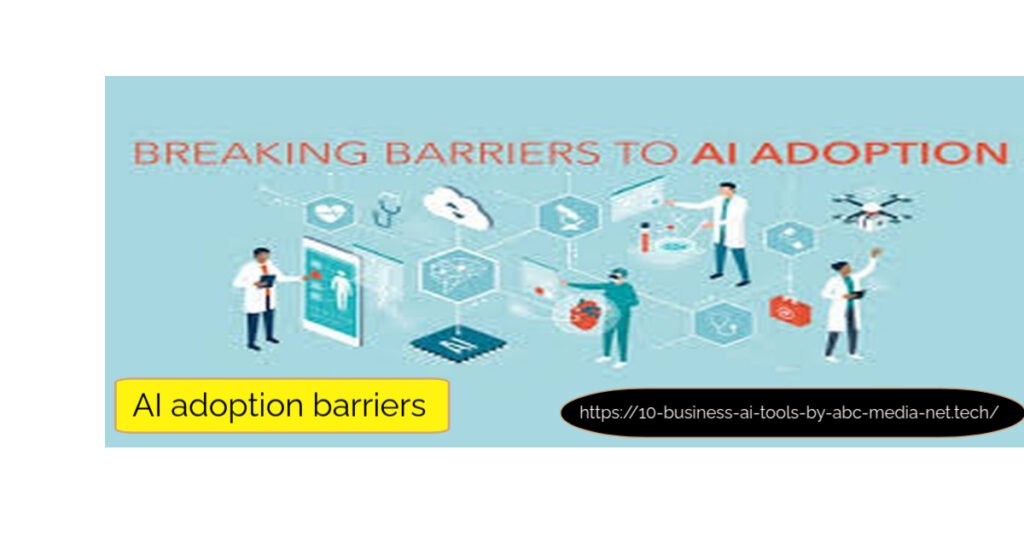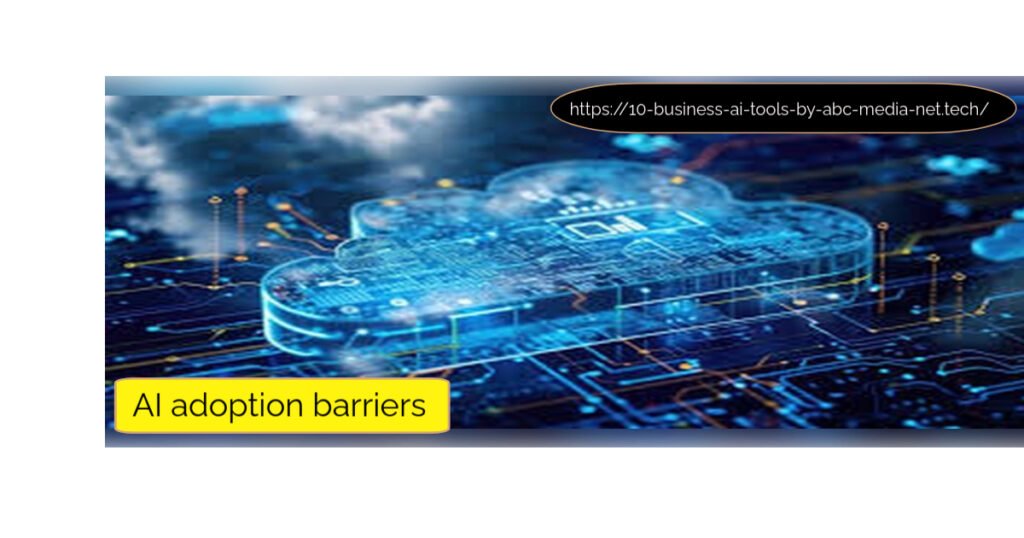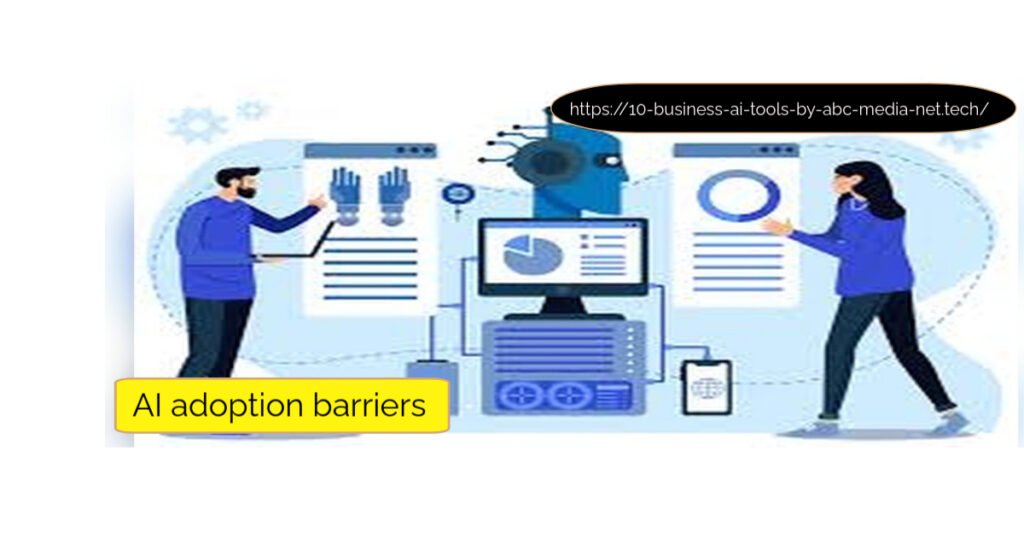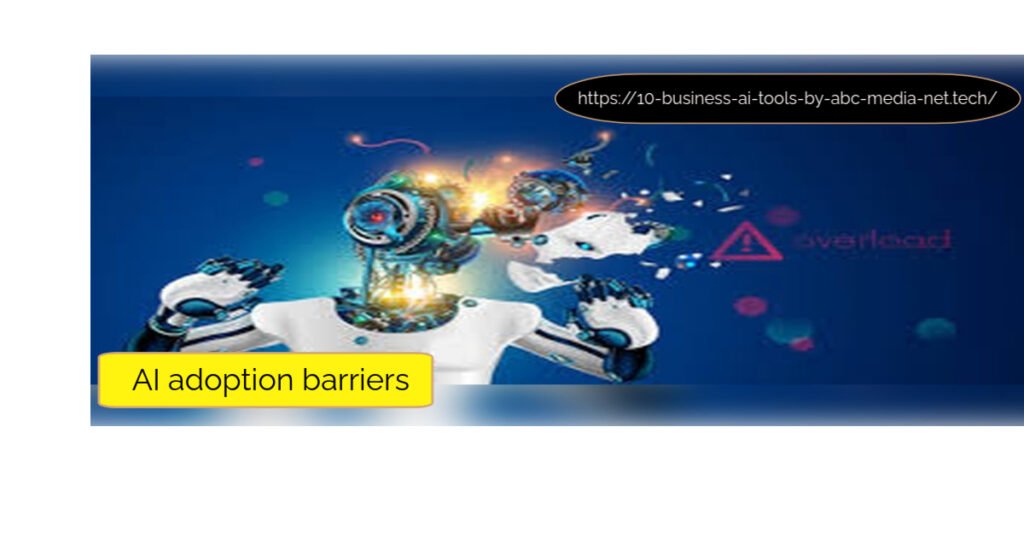Table of Contents
- Introduction to AI Adoption Barriers
- Common AI Adoption Barriers in Business
- High Costs and Financial Constraints
- Lack of Skilled Talent and Expertise
- Data Privacy and Security Concerns
- Integration with Legacy Systems
- Organizational Resistance and Cultural Barriers
- Ethical Concerns and Bias
- Regulatory and Compliance Challenges
- Strategies to Overcome AI Adoption Barriers
- The Future of AI Adoption: Overcoming Barriers for Business Growth
- FAQs: AI Adoption Barriers
- Conclusion
Artificial Intelligence (AI) is revolutionizing various sectors, from healthcare to finance and retail. Businesses are increasingly recognizing the transformative power of AI in streamlining operations, enhancing customer experiences, and driving innovation. However, despite the potential benefits, many companies face significant AI adoption barriers that hinder the full implementation of AI solutions. These barriers range from technical challenges and high costs to data privacy concerns and workforce resistance.
In this comprehensive blog, we will delve into the primary AI adoption barriers that businesses encounter and explore strategies to overcome them. By understanding and addressing these challenges, organizations can better position themselves to harness AI’s transformative power, staying competitive in an ever-evolving digital landscape.2. Common AI Adoption Barriers in Business
1. Introduction to AI Adoption Barriers
AI has become a buzzword in the business world, often associated with innovation, efficiency, and competitive advantage. From automating routine tasks to providing insights through data analytics, AI offers numerous benefits that can drive growth and transformation. However, the journey to AI adoption is fraught with challenges.
Businesses, especially those new to AI, often encounter various AI adoption barriers that make it difficult to implement AI technologies effectively. These barriers are not just technical; they encompass financial, organizational, ethical, and regulatory aspects that require careful navigation. Understanding these barriers is the first step toward developing a strategy that enables organizations to leverage AI effectively and responsibly.

2. Common AI Adoption Barriers in Business
High Costs and Financial Constraints
One of the most significant AI adoption barriers is the high cost associated with implementing AI solutions. Building AI systems requires substantial investment in infrastructure, software, and specialized talent.
- Initial Investment: Developing AI systems often necessitates purchasing high-performance computing hardware, acquiring advanced software licenses, and setting up a robust data management infrastructure. This can result in a significant upfront financial burden, especially for small and medium-sized enterprises (SMEs).
- Ongoing Maintenance: AI systems require continuous monitoring, updates, and maintenance to function effectively. This ongoing cost can quickly add up, making it challenging for businesses with limited budgets to sustain their AI initiatives.
- Return on Investment (ROI) Uncertainty: The uncertain ROI of AI projects can make it difficult for businesses to justify the high initial and ongoing costs. AI adoption often requires a long-term perspective, and some companies may struggle to see the immediate financial benefits, leading to hesitation in investment.
Lack of Skilled Talent and Expertise
AI adoption barriers also stem from a lack of skilled talent. Implementing AI solutions requires expertise in data science, machine learning, and AI-specific programming languages. However, there is a global shortage of professionals with these skills.
- Talent Shortage: The demand for AI specialists far exceeds the supply. Data scientists, machine learning engineers, and AI experts are highly sought after, leading to a competitive job market where businesses must offer attractive compensation packages to secure top talent.
- Skills Gap: Many existing employees lack the necessary skills to work with AI technologies. The rapid pace of AI development means that employees need continuous training to keep up with new tools and methodologies. This skills gap presents a significant AI adoption barrier for companies looking to build an AI-capable workforce.
- Complexity of AI Technologies: AI technologies can be complex and require a deep understanding of algorithms, data analysis, and programming. This complexity can be daunting for businesses that do not have an existing foundation in data analytics or advanced technologies.
Data Privacy and Security Concerns
Data privacy and security are among the most pressing AI adoption barriers. AI systems rely on large datasets to function effectively, but collecting, storing, and processing this data raises concerns about privacy and security.
- Compliance with Data Privacy Regulations: Laws like the General Data Protection Regulation (GDPR) and the California Consumer Privacy Act (CCPA) impose strict requirements on data collection, storage, and usage. Businesses must navigate these regulations carefully to avoid legal pitfalls, which can complicate AI adoption.
- Risk of Data Breaches: AI systems often handle sensitive information, making them prime targets for cyberattacks. A data breach can have severe consequences, including financial losses, reputational damage, and legal penalties.
- Data Anonymization Challenges: Ensuring data privacy while maintaining data utility for AI training is a complex task. Anonymizing data to protect individual privacy can limit the AI system’s ability to draw meaningful insights, creating a trade-off between data privacy and AI performance.
Integration with Legacy Systems
Another significant AI adoption barrier is the challenge of integrating AI with existing legacy systems. Many businesses operate on traditional IT infrastructures that may not be compatible with modern AI technologies.
- Incompatibility with Legacy Systems: Legacy systems often lack the flexibility and scalability required to support AI implementations. Integrating AI with these systems can be a complex, time-consuming, and costly process, often requiring significant modifications to existing workflows.
- Operational Disruptions: AI adoption can lead to temporary disruptions in business operations as companies transition from legacy systems to AI-enabled processes. These disruptions can affect productivity and create resistance among employees who are accustomed to existing workflows.
- Data Silos: Data stored in disparate systems or silos can hinder AI adoption. AI requires access to large, diverse datasets for training, and data fragmentation can limit the quality and quantity of data available for AI algorithms.
Organizational Resistance and Cultural Barriers
AI adoption barriers are not only technical but also cultural. Organizational resistance and a lack of cultural readiness for AI can impede the successful integration of AI technologies.
- Fear of Job Displacement: Employees may perceive AI as a threat to their job security, leading to resistance to AI adoption. This fear can result in a lack of cooperation, hindering the effective implementation of AI solutions.
- Lack of Trust in AI: Many employees and decision-makers may not fully trust AI systems, especially when it comes to critical business decisions. Concerns about AI’s reliability, accuracy, and transparency can create skepticism and reluctance to adopt AI.
- Change Management: Implementing AI often requires changes in organizational processes and structures. Without a clear change management strategy, businesses may struggle to foster a culture that embraces AI and its potential benefits.
Ethical Concerns and Bias
Ethical concerns and the risk of AI bias are significant AI adoption barriers that can have far-reaching consequences for businesses and society.
- Algorithmic Bias: AI systems are trained on historical data, and if this data contains biases, the AI model can learn and perpetuate these biases in its decision-making. This can result in unfair outcomes, such as biased hiring practices or discriminatory loan approvals.
- Ethical Dilemmas: AI systems can raise ethical questions, such as how they make decisions in morally complex situations. For example, in healthcare, an AI system might prioritize certain treatments based on data-driven predictions, potentially overlooking individual patient needs and ethical considerations.
- Transparency and Accountability: Many AI models, particularly deep learning algorithms, operate as “black boxes,” making it difficult to understand how they arrive at their decisions. This lack of transparency can lead to ethical concerns and make it challenging to hold AI systems accountable for their actions.
Regulatory and Compliance Challenges
AI adoption barriers also include navigating a complex and evolving regulatory landscape. Governments and regulatory bodies are increasingly focusing on the implications of AI, introducing laws and guidelines to ensure its responsible use.

- Compliance with AI Regulations: Businesses must comply with various regulations that govern AI’s use, especially in areas like data privacy, consumer protection, and industry-specific standards. Navigating this regulatory environment can be challenging and time-consuming.
- Liability and Risk Management: Determining liability in cases where AI systems cause harm or make erroneous decisions is a complex legal issue. Businesses must establish clear risk management strategies to address potential legal liabilities associated with AI.
- Intellectual Property Rights: AI systems can create new content, designs, or inventions, raising questions about intellectual property rights. Businesses must navigate these legal complexities to protect their AI-generated assets.
3. Strategies to Overcome AI Adoption Barriers
Reducing Financial Barriers
- Start with Pilot Projects: Instead of a full-scale AI implementation, businesses can start with small pilot projects that focus on specific areas. This allows companies to test AI’s impact, measure ROI, and refine their strategies without a significant upfront investment.
- Leverage Cloud-Based AI Solutions: Cloud-based AI platforms offer scalable, pay-as-you-go services, reducing the need for expensive on-premises infrastructure. These platforms provide businesses with access to AI capabilities without the high costs associated with building and maintaining in-house systems.
- Seek Funding and Partnerships: Explore funding options such as government grants, research funding, or partnerships with AI vendors and research institutions. Collaborative efforts can help businesses offset the costs of AI adoption.
Bridging the Talent Gap
- Invest in Training and Upskilling: Implement training programs to upskill existing employees in AI-related fields such as data science, machine learning, and data analytics. This not only addresses the talent shortage but also fosters a culture of continuous learning within the organization.
- AI-as-a-Service: Utilize AI-as-a-Service (AIaaS) platforms that offer pre-built AI models and require minimal technical expertise. AIaaS enables businesses to access AI capabilities without the need for specialized in-house talent.
- Collaborate with Academic Institutions: Partner with universities and educational institutions to create internship programs, AI research projects, and talent pipelines. Collaboration with academia can provide businesses with access to emerging AI talent.
Ensuring Data Privacy and Security
- Implement Data Governance Frameworks: Establish data governance policies that outline data collection, storage, and usage practices. Ensure compliance with data privacy regulations like GDPR and CCPA to protect customer data and maintain trust.
- Data Anonymization and Encryption: Use data anonymization and encryption techniques to protect sensitive information. Anonymizing data can help mitigate privacy risks while preserving data utility for AI training.
- Risk Assessment and Security Measures: Conduct regular risk assessments to identify and address data privacy and security vulnerabilities. Implement robust security measures, including encryption, access controls, and intrusion detection systems, to safeguard AI systems and data.
Facilitating Integration with Legacy Systems
- Use Modular AI Solutions: Choose AI solutions that are designed to be modular and compatible with existing systems. Modular AI tools can be integrated incrementally, minimizing disruptions to current workflows.
- Data Integration and Management: Implement data integration tools that consolidate data from disparate sources into a unified data warehouse. This allows AI systems to access the necessary data for training and decision-making.
- Consult with AI Integration Experts: Engage AI integration experts or consultants who specialize in merging AI technologies with legacy systems. Their expertise can streamline the integration process and ensure a smoother transition.
Overcoming Organizational Resistance
- Change Management and Communication: Develop a change management strategy that includes clear communication about the benefits and implications of AI adoption. Address employee concerns by highlighting how AI can enhance their roles rather than replace them.
- Involve Employees in AI Initiatives: Involve employees in the AI adoption process by seeking their input and feedback. Provide training and support to help them understand and work with AI tools, fostering a sense of ownership and collaboration.
- Promote a Culture of Innovation: Foster a culture that embraces innovation and continuous learning. Encourage employees to view AI as a tool that can augment their capabilities, improve productivity, and open up new opportunities for growth.
Addressing Ethical Concerns and Bias

- Develop Ethical AI Guidelines: Establish ethical AI guidelines that outline principles for fairness, transparency, and accountability. These guidelines should include regular audits of AI systems to identify and mitigate biases.
- Use Diverse and Representative Datasets: Ensure that AI models are trained on diverse and representative datasets to minimize bias. Diverse data helps AI systems make fairer and more equitable decisions.
- Explainable AI: Implement explainable AI (XAI) techniques that make AI decision-making processes more transparent and understandable. This allows businesses to justify AI decisions and build trust with stakeholders.
Navigating Regulatory and Compliance Challenges
- Stay Informed on AI Regulations: Stay up-to-date with the evolving regulatory landscape related to AI. Work with legal experts to ensure compliance with data privacy laws, industry standards, and emerging AI regulations.
- Implement AI Risk Management Strategies: Develop risk management strategies that address potential legal liabilities associated with AI. This includes establishing procedures for addressing incidents where AI systems cause harm or errors.
- Intellectual Property Protection: Protect AI-generated assets by securing intellectual property rights through patents, copyrights, or trademarks. This ensures that businesses retain ownership and control over their AI innovations.
4. The Future of AI Adoption: Overcoming Barriers for Business Growth
As AI technologies continue to evolve, businesses must navigate the complex landscape of AI adoption barriers to unlock AI’s full potential. By addressing financial constraints, bridging the talent gap, ensuring data privacy, integrating AI with existing systems, overcoming organizational resistance, and addressing ethical and regulatory challenges, businesses can pave the way for successful AI adoption.
The future of AI in business lies in responsible and strategic adoption. Businesses that proactively tackle AI adoption barriers and leverage AI’s transformative capabilities will be well-positioned to drive innovation, enhance competitiveness, and achieve long-term growth in a rapidly changing digital world.
6. Conclusion
AI offers immense potential to transform businesses across industries, but its adoption is not without challenges. From high costs and lack of skilled talent to data privacy concerns and organizational resistance, AI adoption barriers can impede the implementation of AI technologies. However, by understanding these barriers and implementing strategic solutions, businesses can successfully navigate the complexities of AI adoption.
The key to overcoming AI adoption barriers lies in a proactive approach that includes financial planning, workforce development, ethical considerations, regulatory compliance, and cultural change. As businesses continue to embrace AI, those that address these barriers head-on will be well-equipped to harness AI’s full potential, driving innovation and achieving sustainable growth in a rapidly evolving digital landscape.
5. FAQs: AI Adoption Barriers
1. What are the main barriers to AI adoption in business?
The main barriers to AI adoption in business include high costs and financial constraints, lack of skilled talent, data privacy and security concerns, integration with legacy systems, organizational resistance, ethical concerns and bias, and regulatory and compliance challenges.
2. How can businesses overcome the high costs of AI adoption?
Businesses can overcome the high costs of AI adoption by starting with pilot projects, using cloud-based AI solutions that offer scalable and cost-effective services, and exploring funding options such as government grants or partnerships with AI vendors.
3. How can companies address the lack of AI expertise in their workforce?
Companies can address the lack of AI expertise by investing in training and upskilling programs to equip existing employees with AI-related skills, using AI-as-a-Service platforms that require minimal technical expertise, and collaborating with academic institutions to source emerging AI talent.
4. What role does data privacy play in AI adoption?
Data privacy is crucial in AI adoption, as AI systems rely on large datasets for training and decision-making. Businesses must ensure compliance with data privacy regulations, implement data governance frameworks, and use data anonymization and encryption to protect sensitive information.
5. How can businesses integrate AI with legacy systems?
Businesses can integrate AI with legacy systems by using modular AI solutions designed for compatibility, employing data integration tools to consolidate data from disparate sources, and consulting with AI integration experts to streamline the process and minimize disruptions.
6. How can organizations overcome resistance to AI adoption among employees?
Organizations can overcome resistance to AI adoption by implementing change management strategies, communicating the benefits of AI, involving employees in AI initiatives, providing training and support, and promoting a culture of innovation that views AI as a tool for enhancing roles.
7. What steps can businesses take to address ethical concerns and bias in AI?
Businesses can address ethical concerns and bias by developing ethical AI guidelines, using diverse and representative datasets to train AI models, implementing explainable AI (XAI) techniques for transparency, and conducting regular audits to identify and mitigate biases.
8. How do regulatory and compliance challenges impact AI adoption?
Regulatory and compliance challenges impact AI adoption by imposing requirements related to data privacy, consumer protection, and industry-specific standards. Businesses must navigate these regulations to ensure legal compliance, avoid liabilities, and protect intellectual property rights.
9. Can AI be successfully adopted without a large initial investment?
Yes, AI can be successfully adopted without a large initial investment by starting with small-scale pilot projects, using cloud-based AI services, and exploring funding options such as grants and partnerships. This approach allows businesses to test AI’s impact and scale up gradually.
10. What is the future outlook for AI adoption in business?
The future outlook for AI adoption in business is promising, with AI expected to play a central role in driving innovation, efficiency, and competitiveness. Businesses that overcome AI adoption barriers and adopt AI responsibly will be better positioned for growth and success in the digital age






